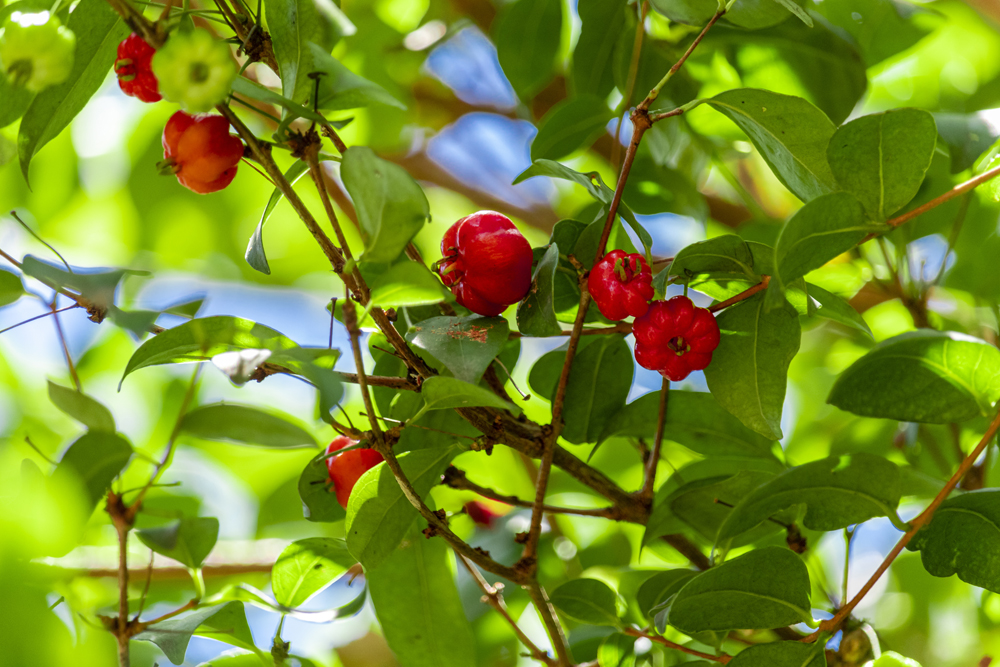Eugenia sp. or Syzygium sp.
Common Name:
Brush cherries

General information:
Eugenia is a large group of plants, some native and some non-native, including evergreen trees and shrubs, some of which have been reclassified to the genus Syzygium. The evergreen leaves are firm and glossy, and the flowers white. It is the dried buds of Eugenia aromatica (Syzygium aromaticum) which become the fragrant “herb” cloves. The flowers are followed by the production of berries, some types of which are edible. All these traits - the attractive foliage, flowers, and berries - help make Eugenia a popular landscape choice in warm climate areas, such as California, Florida, and Hawaii. Eugenia confusa (Ironwood, Red Stopper) is native to Florida and grows to about 35 feet and is well suited for street tree and parking lot planting. Eugenia foetida (Spanish Stopper) is also native and grows to about 15 feet tall.
A sub-tropical evergreen, with dark green ovate leaves formed in pairs. In spring, may bear small white flowers followed by red, edible fruit. With the exception of jaboticaba, Eugenia species have red, flaking bark. Surinam cherry is used extensively as a hedge plant in the Southern US.
Family:
Myrtaceae
Lighting:
Full sun to part shade. Appreciates a bright position, about 1500 Lux, but can tolerate low light. If placed outdoors in summer, can usually tolerate full sun, although partial shade is recommended in the hottest areas.
Temperature:
Never below 30F. Generally hardy in zones 10B and 11, otherwise can successfully be grown indoors. In summer, Eugenia likes the heat, while it prefers winter temperatures between 46-68F. Eugenia does not like drafts or a lot of variation in temperature.
Watering:
Generously in summer, less in winter. Surinam cherry does not like variations in watering, preferring a consistently slight moisture to being soaked and allowed to dry out. Lesniewicz recommends that Australian Brush cherry dry a little between waterings, but some posts testify that it will drop leaves if the soil dries. Eugenia needs humidity, so misting can be beneficial. Use distilled/rain water if your water is hard, as Eugenia does not tolerate salt.
Feeding:
Every 2 weeks during heavy growth, and every 4-5 in winter. Eugenia likes a slightly acid soil, so the occasional use of Miracid is recommended.
Pruning and wiring:
Can be pruned back hard, as it is a vigorous grower. Shorten new shoots with 6-8 pairs of leaves to 1-2 pairs. Can be wired while in active growth, but better shaping results are achieved with pruning. Protect the branches, as they scar easily. Leaf pruning can be done in summer on strong plants, but is not generally advised, as better leaf reduction results from timely pruning, and this plant has relatively small leaves in the first place. It is suitable for all styles, and for all but the largest sizes.
Propagation:
By cuttings in summer, seeds in fall, air-layering.
Repotting:
Every two years in early to mid-spring. Bottom heat helps to encourage root growth. Use basic bonsai soil, or an acid mix like azalea soil. Will withstand vigorous root pruning: jaboticaba can take up to 2/3 root loss, and while I would not recommend the following as a normal practice, up to 90% root removal has been performed successfully on Surinam cherry!
Pests and diseases:
Pests:
Scale, mealy bug, Caribbean fruit fly, aphids, red spider. Psyllids limit the tree’s usefulness in parts of California.
Diseases:
No diseases are of major concern. May drop leaves if watering is inconsistent. Not salt tolerant.
Some species suitable for bonsai:
Eugenia brasiliensis: Brazil cherry - likes slightly higher winter temperatures (64-68F) than other Eugenia species. Needs good light for its red, edible fruit to develop.
Eugenia cauliflora: Jaboticaba - Native from southern Brazil to southern California, southern Florida and Hawaii, the jaboticaba has creamy tan bark with pinkish and greyish highlights that peels in long strips like crepe myrtle. It will bear purple edible ovoid fruit when the plant is about 15 years old. Expect the jaboticaba to lose about half its leaves in early spring, before the new growth sets in.
Eugenia myrtifolia (also called Syzygium paniculatum): Australian brush cherry - Grows to 20 feet. Red, egg-shaped edible fruits. If it receives enough light, the leaves will develop red highlights. Prefers winter temperatures of 59-64F.
Eugenia myrtifolia var. Globulus (also called Syzygium paniculatum): ‘Teenie Genie’ cherry - a popular, widely available choice, much loved for bonsai due to its extremely small leaves.
Eugenia uniflora: Surinam cherry, Brazil cherry, pitanga - hardy to zone 10, this tropical “cherry” has round red and yellow fruits, which can be used in preserves and sherbets.
Bibliography:
USDA Fact Sheet ST-241
Compiled by Sabrina Caine Edited by Thomas L. Zane
